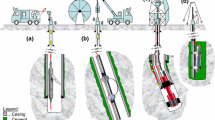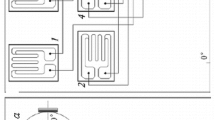Abstract
A new probe has been constructed for making temperature measurements 1.1 m ahead of the bit in Ocean Drilling Program (ODP) boreholes. Temperatures are recorded at positions 1 and 11 cm above the tip of the probe. The combination of the dual temperature records and accelerometer data provides valuable information about disturbances that may affect the quality of measurements. Long battery life, and memory access via an external communications port, allow service-free operation for the full duration of typical drilling legs. Temperature resolution varies over the 110 K measurement range, from nominally 1 mK from -5 to 20 °C, to about 10 mK at 105 °C. The small (8 mm) diameter of the probe tip allows rapid thermal equilibration after penetration. The shallow (2.5°), continuous taper of the lower part of the probe serves to reduce the tendency of the formation to be cracked when the tool is pushed into the formation. It is sufficiently robust, however, to survive penetration into highly consolidated sediment and occasional contact with igneous rock. The tool was used for a total of 44 bottom-hole temperature measurements between 38 and 573 meters below seafloor (mbsf) during Leg 168, as well as for several logging runs in open holes. We anticipate adding a port in the tip to permit measurement of formation fluid pressure, and to enhance the utility of the tool for logging temperature profiles in open holes.
Similar content being viewed by others
References
Barnes, R. O., 1988, ODP In Situ Fluid Sampling and Measurement: A New Wire line Tool, Proc. Ocean Drill. Prog., Init.Res. 110, 55–63.
Bullard, E. C., 1954, The Flow of Heat Through the Floor of the Atlantic Ocean, Proc. Roy. Soc. Lond., A 222, 408–429.
Davis, E. E., Fisher, A. T., Firth, J. V., and the Shipboard Scientific Party, 1997, Proc. ODP, Init. Repts., 168: College Station, TX (Ocean Drilling Program) (in press).
Erickson, A. J., 1984, Theory, Techniques, and Interpretation of Down hole Temperature Measurements, in Heath, R. R. (ed.), Sedimentlogy, Physical Properties, and Geochemistry in the Initial Reports of the Deep Sea Drilling Project: An Overview, National Oceanic and Atmospheric Administration, Boulder, CO, pp. 105–121.
Erickson, A. J., 1973, Initial Report on Down hole Temperature and Shipboard Thermal Conductivity Measurements, Leg 19, Init. Rep. Deep Sea Drill. Proj. 19, 643–656.
Erickson, A. J., Von Herzen, R. P., Sclater, J.G., Girdler, R.W., Mar-shall, B.V., and Hyndman, R.D., 1975,GeothermalMeasurements in Deep-Sea Drill Holes, J. Geophys. Res. 80, 2515–2528.
Fisher, A. T., Becker, K., and Davis, E. E., 1997, The Permeability of Young Oceanic Crust East of Juan de Fuca Ridge Determined Using Borehole Thermal Measurements, Geophys. Res. Lett. (in press).
Horai, K. and Von Herzen, R. P., 1985, Measurement of Heat Flow on Leg 86 of the Deep Sea Drilling Project, Init. Rep. Deep Sea Drill. Proj. 86, 759–777.
Hyndman, R.D., Davis, E. E., and Wright, J. A., 1979, The Measure-ment of Marine Geothermal Heat Flow by a Multipenetration Probe with Digital Acoustic Telemetry and in-situ Conductivity, Marine Geophys. Res. 4, 181–205.
Hyndman, R. D., Langseth, M. G., and Von Herzen, R. P., 1987, Deep Sea Drilling Project Geothermal Measurements: A Review, Rev. Geophys. 25, 1563–1582.
Lister, C. R. B., 1979. The Pulse-Probe Method of Conductivity Measurement, Geophys. J. Roy. Astr. Soc. 57, 451–461.
Sass, J. H., Kennelly, J. P., Jr., Wendt, W. E., Moses, T. H. Jr., and Ziagos, J. P., 1981, In-Situ Determination of Heat Flow in Unconsolidated Sediments, Geophysics 46, 76–83.
Villinger, H. and Davis, E. E., 1987, A New Reduction Algorithm for Marine Heat Flow Measurements, J. Geophys. Res. 92, 12846–12856.
Von Herzen, R. P., Fiske, R. J., and Sutton, G., 1971, Geothermal Measurements on Leg 8, Init.Res. Deep Sea Drill. Proj. 8, 837–850.
Von Herzen, R. P. and Maxwell, A. E., 1959, The Measurement of Thermal Conductivity of Deep-Sea Sediments by a Needle Probe Method, J. Geophys. Res. 64, 1557–1563.
Yokota, T., Kinoshita, H., and Uyeda, S., 1980, New DSDP (Deep Sea Drilling Project) Downhole Temperature Probe Utilizing Di-gital Self-Recording System with IC RAM (Memory) Elements, Bull. Earthquake Res. Inst. Univ. Tokyo 55, 75–88.
Author information
Authors and Affiliations
Rights and permissions
About this article
Cite this article
Davis, E.E., Villinger, H., MacDonald, R.D. et al. A Robust Rapid-Response Probe for Measuring Bottom-Hole Temperatures in Deep-Ocean Boreholes. Marine Geophysical Researches 19, 267–281 (1997). https://doi.org/10.1023/A:1004292930361
Issue Date:
DOI: https://doi.org/10.1023/A:1004292930361




